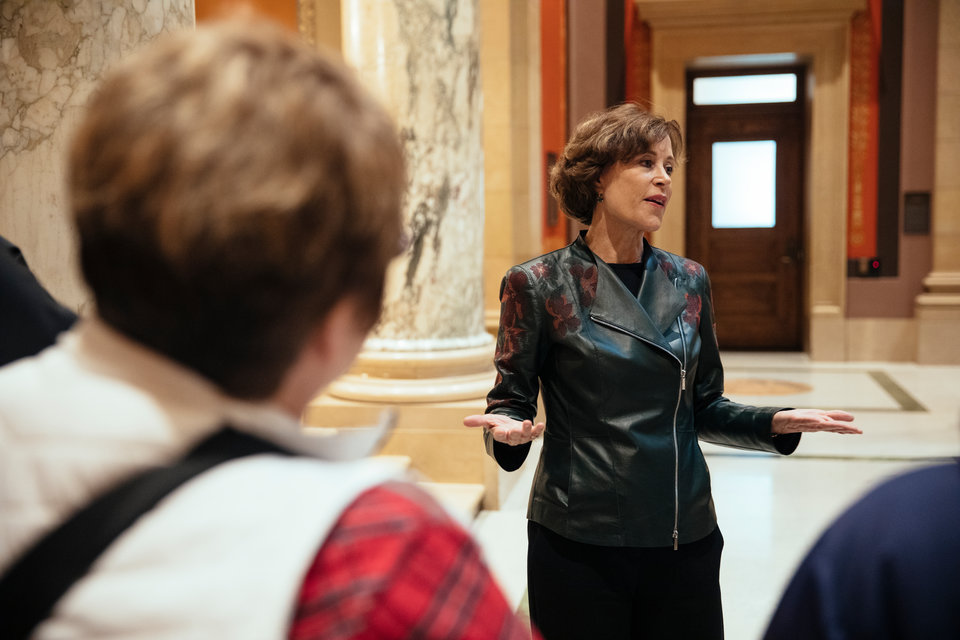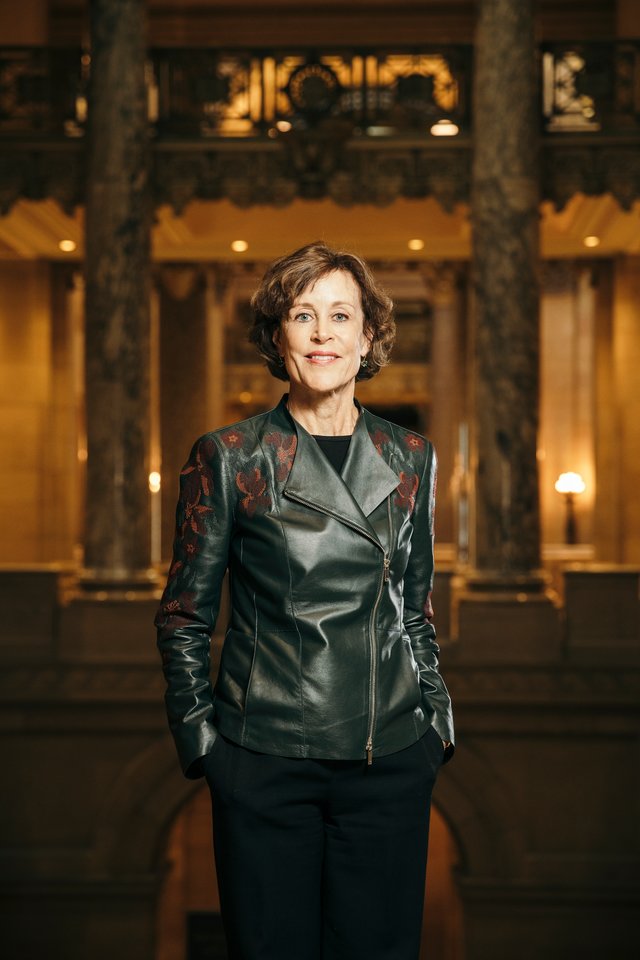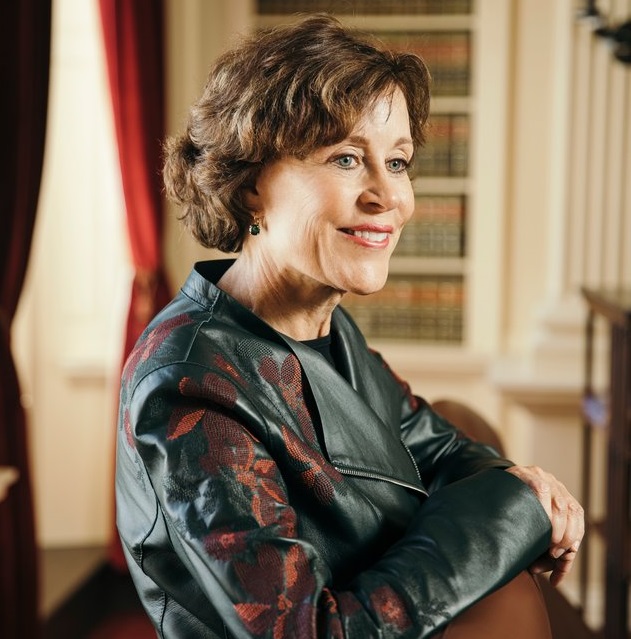Kathleen Blatz is Minnesota’s first female Supreme Court Chief Justice, the youngest female legislator in state history, and the only woman to have served in the Legislature and on the state’s Supreme Court. She was a lawmaker for 27 years, from her legislative swearing-in ceremony in 1979 to her retirement from the bench in 2006. Yet, she never set out to accomplish the extraordinary. Blatz said, “I followed my passions. I did not have a chartered course or a script – ever – about what I did or the decisions I made. Someone asked if I was interested in the Legislature, and because in my family public service was normalized, I wasn’t intimidated. My preparation met opportunity, and I had passion.”
Opportunity presents itself
Blatz was the second of Jerome and Kaye Blatz’s seven daughters and two sons. Jerome was a lawyer; Kaye, a social worker. At 8 years old, Blatz and her siblings spent Saturday mornings dropping literature on Bloomington doorsteps in support of their father’s campaign for the Minnesota Senate. Growing up the child of a legislator, public service was familiar to Blatz – not daunting, out of reach, or something to be shrugged off onto others.
Blatz attended the Academy of Holy Angels and went on to graduate from the University of Notre Dame in 1976. She received her master’s degree in social work in 1978 and her juris doctor degree in 1984, both from the University of Minnesota.
When she was approached at age 23 to run against an incumbent member of the state House of Representatives, she was not apprehensive … nor when she won. Sworn into office at age 24, Blatz was – and continues to be – the youngest female legislator in state history.
Chairing the Crime and Family Committee in the mid-1980s was a defining moment for her. The state and the nation had been gripped by the infamous Cermak case, which involved multi-perpetrator, multi-victim sexual abuse of minors. Minnesota became focused on child abuse prevention and treatment. In that moment, Blatz was “steeped in child abuse.” She recalled, “It just happened that I was in a position that put me in the vortex of the problem.”
Ultimately, Blatz’s advocacy on behalf of abused and neglected children caught the attention of Gov. Arne Carlson, who appointed her to the Hennepin County District Court bench in 1994, as associate justice of the Minnesota Supreme Court in 1996, and finally as chief justice in 1998. Carlson, who had been a foster parent, told Blatz, “I share your passion for helping abused children, and I hope you do something with it.”
Blatz credits her service as a legislator for shaping her approach as a judge. “Having been part of the Legislature, it deepened my respect for and understanding of the co-equal branches of government,” Blatz said.
One case presented to the Minnesota Supreme Court required interpretation of a statute that Blatz had unsuccessfully fought to change when she was a legislator. While one party argued that the law was unfair – a view Blatz shared – Blatz remembers deciding with the other justices that it was not up to them to fix the statute; it was up to the Legislature.
Foundationally, Blatz’s favorite part of being a judicial officer was deciding cases. “I love the justice part of being a judge. Every case affected real people. When I became chief justice, I liked the opportunity for real change.”
Among Blatz’s many accomplishments as chief was the establishment of the Minnesota Judicial Council, the administrative policy-making authority for the Minnesota Judicial Branch. The Judicial Council operates as a collaboration involving all parts of the judiciary and remains a national model. Blatz also opened Minnesota’s juvenile courts to the public to increase transparency and accountability for decisions affecting vulnerable children’s lives. And she spearheaded the Children’s Justice Initiative, a collaboration between the Minnesota Judicial Branch and Department of Human Services to timely find safe, stable, permanent homes for abused and neglected children.
Blatz’s passion for children was not limited to Minnesota. She also co-chaired a national conference involving teams of judicial branch and executive branch representatives from every state to improve handling of child protection cases.

Former Minnesota legistator and Minnesota Supreme Court Chief Justice Kathleen Blatz talks with a tour group in the Minnesota State Capitol Building in St. Paul on March 11, 2019.
Lighting the path
Blatz decided to attend law school while she was serving in the Legislature. “I picked my legislative committees around my classes, and my classes around my committees. I would go back and forth all day. When I look back, I remember how stressful it was . . . but at the time it was just life.”
In her first year of law school, grades in three of her classes were based entirely on four-hour tests that covered the entire year. Blatz recalled the morning of her Constitutional Law exam: “We were in session under call of the House, which means that I had to get permission to even leave the floor of the House. I raised my hand and Speaker of the House Harry Sieben said, ‘The lady from Hennepin is excused.’ I left, and my voting button was locked. I drove to Minneapolis and took a four-hour Con Law test, and when I came back they were still on the same bill . . . on the 17th Amendment to be exact. And then I was back voting. That’s how I lived my life. Nobody even knew I was gone.”
Blatz also tackled life challenges with gusto. After graduating from law school, while simultaneously practicing law and serving in the Legislature, Blatz became a mother to three children in six years. She vaguely remembers the stress and busyness of those years, yet recalls her parenting philosophy: “Every day when I woke up, I had no ‘money’ in the bank. At the end of the day, I wanted to deposit something for each child. There was no running balance. I could not draw on the days before. I could not skip days. Some bad days did happen, but I tried to string together enough days where I added to the balance that things would turn out OK for my kids. And they did.”
Patrick Shrake ’04 clerked for Blatz at the end of her tenure on the Court. He observed, “I learned so much from Chief Justice Blatz about the importance of family and cherishing the time we have with the ones we love.”
With all the effort that Blatz invested in both her personal and professional lives, it is surprising to hear her say that becoming the first female chief justice of the Minnesota Supreme Court did not “weigh her down.”
She did not feel like the “first” because of her experiences and all the people who helped her along the way. She had her mother and six sisters, who provided strong female influence. She attended an all-girls high school where female leadership was encouraged. She served and led in the Minnesota Legislature. Finally, she joined a Supreme Court on which women had served before her.
“I can honestly say that I did not feel that mantle of first womanhood in the position. The Court had had a majority of female justices before me.”
In 1991, Minnesota became the first state in the country to have a female majority on its highest court. The female justices were Rosalie Wahl, the first woman appointed to the Court in 1977; M. Jeanne Coyne, appointed in 1982; Esther Tomljanovich, appointed in 1990; and Sandra Gardebring, appointed in 1991.
“They were all very strong women,” Blatz said. “It was seamless. Don’t misunderstand that I thought [my appointment as chief justice] didn’t matter. For all these positions and titles that we hold, it’s important to see women in them. Having occupied the position as a first, I did not feel an onus in the title nor did I feel special. I just did my job.”
A female majority returned to the Court in 2016 when Associate Justice Anne McKeig joined Chief Justice Lorie Skjerven Gildea and Associate Justices Natalie Hudson and Margaret Chutich.
Chief Justice Gildea, the second female chief justice of the Court, said of Blatz, “Chief Justice Blatz lit the lamps that made the path more clear for those women who came after her on the bench and in the legal profession, and there is no question that she used her voice in a way that has made our voices easier to hear.”

Former Minnesota legistator and Minnesota Supreme Court Chief Justice Kathleen Blatz poses for a portrait in the Minnesota State Capitol Building in St. Paul.
A passion for justice
After a life of being a legislator, lawyer and judge, Blatz said, “In the end, it’s not what you practice, it’s how you practice.”
Blatz’s civic engagement has gone beyond legislator and judge and into private, public and nonprofit board of director service, which helps her feel “balanced,” she said. Among the many boards on which she has served, the University of St. Thomas School of Law was honored to have her as a Board of Governors member for a decade, and ultimately as chair.
When Blatz was awarded the Twin Cities Business Lifetime Achievement Award for board service in 2018, Gov. Carlson remarked: “She has always placed integrity above all else and defined the mission in the context of service to others. As a legislator, jurist and board leader, she was constant in her focus and brought colleagues together in a most delightful and engaging fashion. Smart, quick, witty and sensitive, Kathleen provided the glue that brings people together.”
Blatz draws inspiration from Winston Churchill, who said, “We make a living by what we get, but we make a life by what we give.” Minnesota history will remember Blatz as a pioneering female lawmaker. For Blatz, a lifetime of service to others – particularly children – is the greatest measure of her life well lived.


